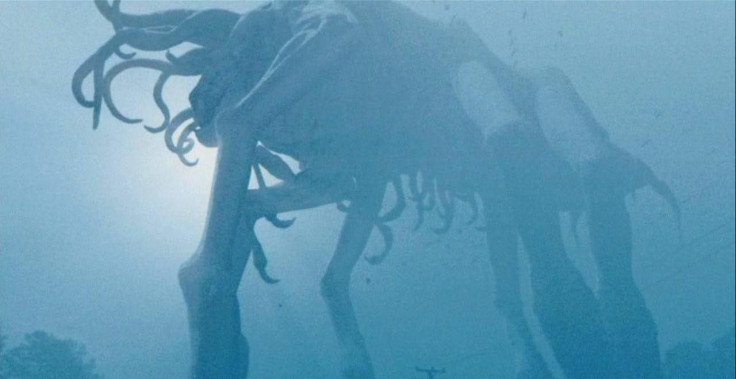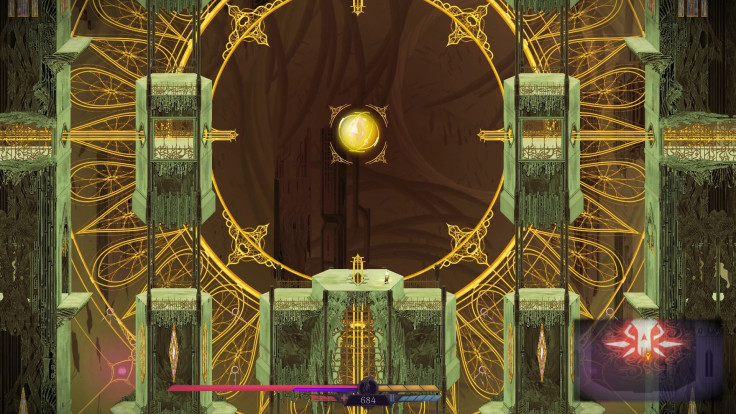Through his Cthulhu Mythos, Howard Phillips Lovecraft — a reclusive, letter-writing, racist poet and short story writer — has become a surprising mainstream success, decades after his death. His work has inspired dozens of movies, including horror classics like Re-Animator, From Beyond, Possession, The Mist, In the Mouth of Madness, The Thing and The Haunted Palace. There are board games, tabletop role-playing games, CCGs and video games. Lovecraftian Great Old Ones pop up in mainstream comic book movies like Hellboy and episodes of South Park. But something is missing from our pop cultural understanding of H.P. Lovecraft’s work. And that something can be found in abundance in Sundered, the new game from Jotun developers Thunder Lotus Games.
Adaptations of Lovecraft tend to lump into two broad categories. One is mindful of the era in which Lovecraft wrote, preserving a 1920s milieu and the New England environs that played home to some of his most famous stories. In multiple adaptations, including RPG Call of Cthulhu, board game Arkham Horror and movie The Whisperer in Darkness, Lovecraft and his era become a totalizing aesthetic, like an alternative to steampunk except with tentacles instead of gears.
But far more often than 1920s Miskatonic University adventures, Lovecraft comes to us via his monsters. Colossal, asymmetric, tentacled monstrosities towering over mankind hold a visual and narrative power absent any other Lovecraftian element. Giant, Cthulhu-like monsters in Justice League, South Park, Skyrim, The Mist, World of Warcraft and countless other video games, movies, TV shows and novels convey our cosmic meaninglessness all on their own. Lovecraft’s bestiary is compelling even shorn of its narrative contexts.

“Lovecraft Country” adventure or monsters, monsters, monsters. Those tend to be the two ways we interact with the Cthulhu Mythos outside of Lovecraft’s stories. But a key element of the source material has gone missing: the grandeur and grotesquerie of civilizations other than our own.
In Sundered, the scavenger Eshe is trapped in the underground temple chambers ruled by the Trapezohedron (from Lovecraft’s short story, “The Haunter of the Dark”), whose alien intellect guides Eshe (and you) through the maze of horrors, always and ever urging you away from the human and toward more daemoniac power and values. Two civilizations, the technological Valkyrie and the mystic priesthood of the Eschaton — not unlike Lovecraft’s cities of Ib and Sarnath — were corrupted in this dark place, twisted into Lovecraftian monsters.
Divided into three immense regions, Sundered understands like few other Lovecraft adaptations that it’s not the monsters that drive his characters mad and leaves readers with creeping dread, but the totality of a world in which human reason counts for nothing.
Whether it’s the strange alloys of the Elder Things city in “The Dreams in the Witch House” or the lost “nightmare corpse-city” of R’lyeh, where “dead Cthulhu waits dreaming,” Lovecraft’s monsters are only a part of his full narrative power.
Lovecraft first described the Elder Things and grotesque shoggoths in the novella “At the Mountains of Madness,” but just as important as the monsters is the city they inhabit. Hidden over a mountain chain in Antarctica, the city of the extraterrestrial Old Ones is described as “a Cyclopean city of no architecture known to man or to human imagination, with vast aggregations of night-black masonry embodying monstrous perversions of geometrical laws and attaining the most grotesque extremes of sinister bizarrerie.”
Oppressive, skin-crawling horror depends on the looming immensity of ancient civilizations that saw no need for mankind’s conception of the universe. Lovecraft’s monsters aren’t chilling because they are bestial, but because they represent an alternate order that makes minuscule the full scope of humanity’s accomplishments. We are reduced to blips, occluded by freakish things with no interest in a communication of values.

While Sundered is far more concerned with action than horror, it brilliantly captures both sides of the Lovecraftian worldview. Swarms of disgusting creatures overwhelm with teeth and tentacles in alien vistas of immense scale. Eshe fights in ancient cities and temples, holy to monsters but repulsive to us. It’s this exact tension that the Trapezohedron works to exploit, growling to you in its unspeakable language, confident in its contempt.
In Lovecraft’s “The Shadow Out of Time,” Nathaniel Wingate Peaslee experiences an inhuman civilization through the eyes of the body-snatching Yithians. “Had I, as the captive mind of those shambling horrors, indeed known that accursed city of stone in its primordial heyday, and wriggled down those familiar corridors in the loathsome shape of my captor?” Lovecraft portrays their immense knowledge and indifference as antithetical to humanity, the ruins of their great library city an affront to our own meager intellects.
The Trapezohedron works the same wiles in Sundered. It finds hideous the waterfalls, lush wildlife and elegant architecture that connote beauty for us. Its holy places are disgusting realms of slime, brambles and titanic earthworks, where crawling, slithering loathsome things live and breed in unearthly caverns and dark forces gather in sickly green clouds. The Trapezohedron tells you the history of these places in reality-bending sequences, where crystals gush blood and the human presence is both profanity and desecration.
Creature features and 1920s cosplay isn’t Lovecraftian horror. Sundered, with its depiction of a monstrous reality, built to a scale beyond our entire species and apart from human reason, comes closer to capturing Lovecraft’s dark dreams than Cthulhu alone ever will.
- Gorgeous and grotesque hand-drawn graphics
- One of the best Lovecraft-inspired games ever
- Unforgettable boss encounters
- Satisfying combat and RPG components
- Level grinding means retreading the same paths again and again



















![[EG April 19] Best 'Stardew Valley' Mods That Will Change](https://d.player.one/en/full/226012/eg-april-19-best-stardew-valley-mods-that-will-change.png?w=380&h=275&f=955520b8313253ee3c39c791f6210f38)